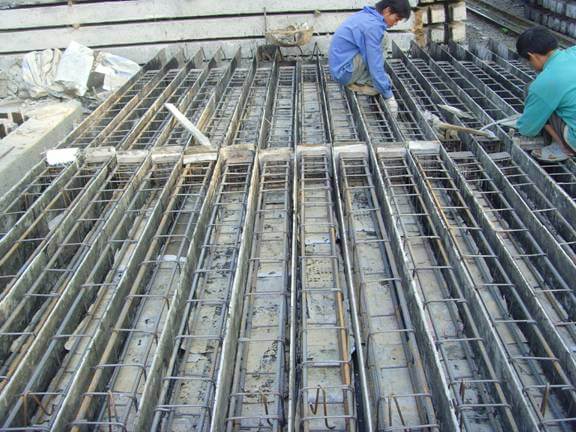News
Coppha board and Concrete casting work
The process of forming a concrete structure with enough bearing capacity as intended, includes the following stages:
- Concrete casting stage: At this stage, the concrete material is still in the form of a mixture of liquid (also called mortar) and fresh (that is not setting), calculated from the time it leaves the mixing plant (the concrete mortar is formed). until the concrete begins to set (starting to form chemical bonds between the mineral components in the concrete mortar, also known as pre-setting). At this stage, the concrete is in liquid form (fresh concrete), so it is easy to form when stored in the mold. (The characteristic for the ease of casting of concrete mortar is the fluidity ie slump of the concrete mixture). The concrete mortar at this time has no bearing strength and has a small consistency that requires compacting. But if we exceed this stage, but we immediately touch the concrete mortar, it will break the bonds that have just formed in the concrete but cannot be permanently restored. Therefore, this phase is the stage where concrete can be constructed and requires a mold to accommodate and withstand the change of concrete. This stage usually lasts about 1.5 – 3.0 hours, depending on the ambient temperature and the type of cement that makes the concrete mortar (for concrete usually without additives) and about 3.0 – 4, 0 hours (for concrete with slow setting additive).
- Curing and curing concrete stage: the concrete mortar is now stable in the mold and gradually forms a system of bonding components in the concrete. As mentioned above, this phase is no longer allowed to construct. This is the stage to control the deformation of the mold so as not to break the setting. At the end of this period the concrete solidifies (the formed concrete structure) and permanently retains the shape that the mold gives it. Temporary loads to be applied to the mold have most effect. At the same time the concrete has started to have a certain strength, so some forms of molded molds are only subjected to temporary loads, after this stage, all the roles can be dismantled. This stage usually lasts about 18 – 24 hours after the concrete has started setting.
- Stage of strength development of the concrete structure: the concrete structure has hardened and increased gradually in a gradual manner, the speed of increase is slower. The mold is still subjected to frequent loads in place of the concrete structure, but the degree decreases with time, due to the gradual takeover of the concrete structure. If the concrete quality is good and fully cured according to the construction standards, the concrete structure can reach its design mark, on day 28. When the concrete reaches a certain strength, enough to bear the loads. With regular weight, depending on the specific conditions specified in the construction standards, it is possible to dismantle the bearing molds (the type of molds subject to both permanent and temporary loads), at the end of this period.

With the above characteristics, when constructing concrete structures, it is necessary to have a concrete casting system with two main tasks: both as a mold or formwork containing mortar to create the design shape. and at the same time bear the force instead of mortar and concrete structures later formed from that mortar, when they do not have or have not met the required bearing capacity as required. Therefore, the structure of all molds usually consists of two main parts:
- Formwork system: the main task is to contain and shape the concrete structure, in addition, to transfer the load to the remaining components. (To be exact, formwork or plate form is just one part of the molding system. All the phrases New scaffold or bracing formwork is equivalent to the mold system. But in construction in Vietnam slowly formwork is often used to refer to the entire formwork system.)
- Bearing system is located outside or below the mold plate: it is responsible for the main load bearing for the entire die structure system. These include: gong, bracing, splashing, support, momentum (horizontal momentum), spear (spear), check chain, …
Requirements for concrete formwork formwork
- The mold must be tight: in order to accommodate the fresh and liquid concrete mortar within it,
- The shape and size of the molds and their installation positions at the building must be in accordance with the mold design, in order to fabricate a concrete structure in accordance with the shape, size and position according to that structural design.
- Mold must maintain its shape to fabricate the structure of concrete and reinforced concrete during the formation of that concrete structure (especially in the second stage of concrete: setting stage and curing). To ensure this requirement, the mold structure needs to be designed with the second limit state: strain limit state.
- The mold must be capable of bearing capacity, as it must bear the load instead of concrete when in mortar concrete and possibly even when the concrete has been cured and the concrete structure is formed, until the concrete reach the strength values that can permit dismantling (especially at the construction stage of concrete, where the concrete is completely unbearable but has the greatest variety of loads at the same time). on the mold). To ensure this requirement, the die structure needs to be designed with the limit state I: strength limit state.
- Molds are construction equipment, so their use is only temporary during the construction of concrete structures. Until the concrete structure has formed and has reached certain strength values that are sufficient for the structure to withstand at least its own weight, the mold ceases to function and needs to be removed and can be reused. Therefore, the mold needs to be designed and fabricated so that it is easy to disassemble.


